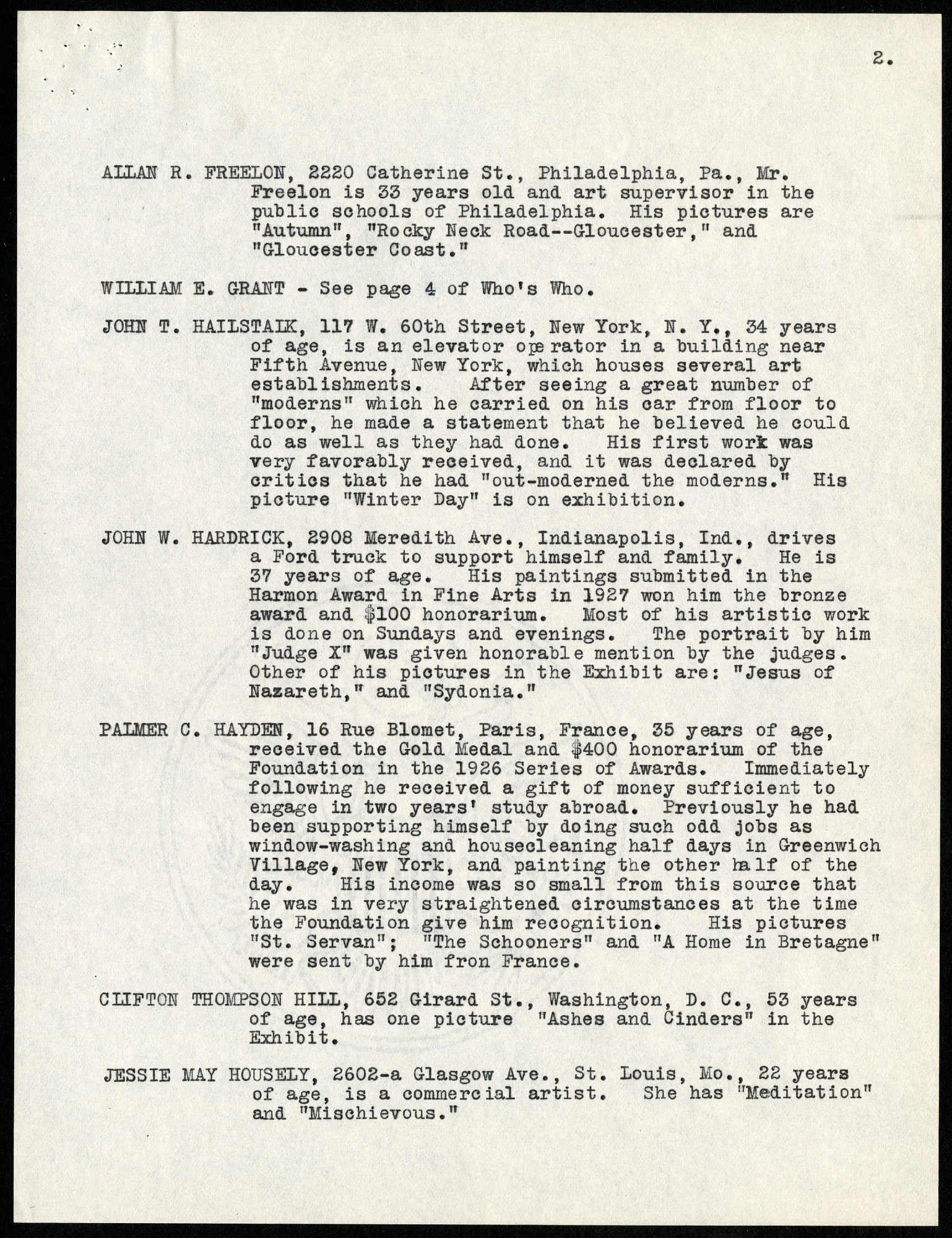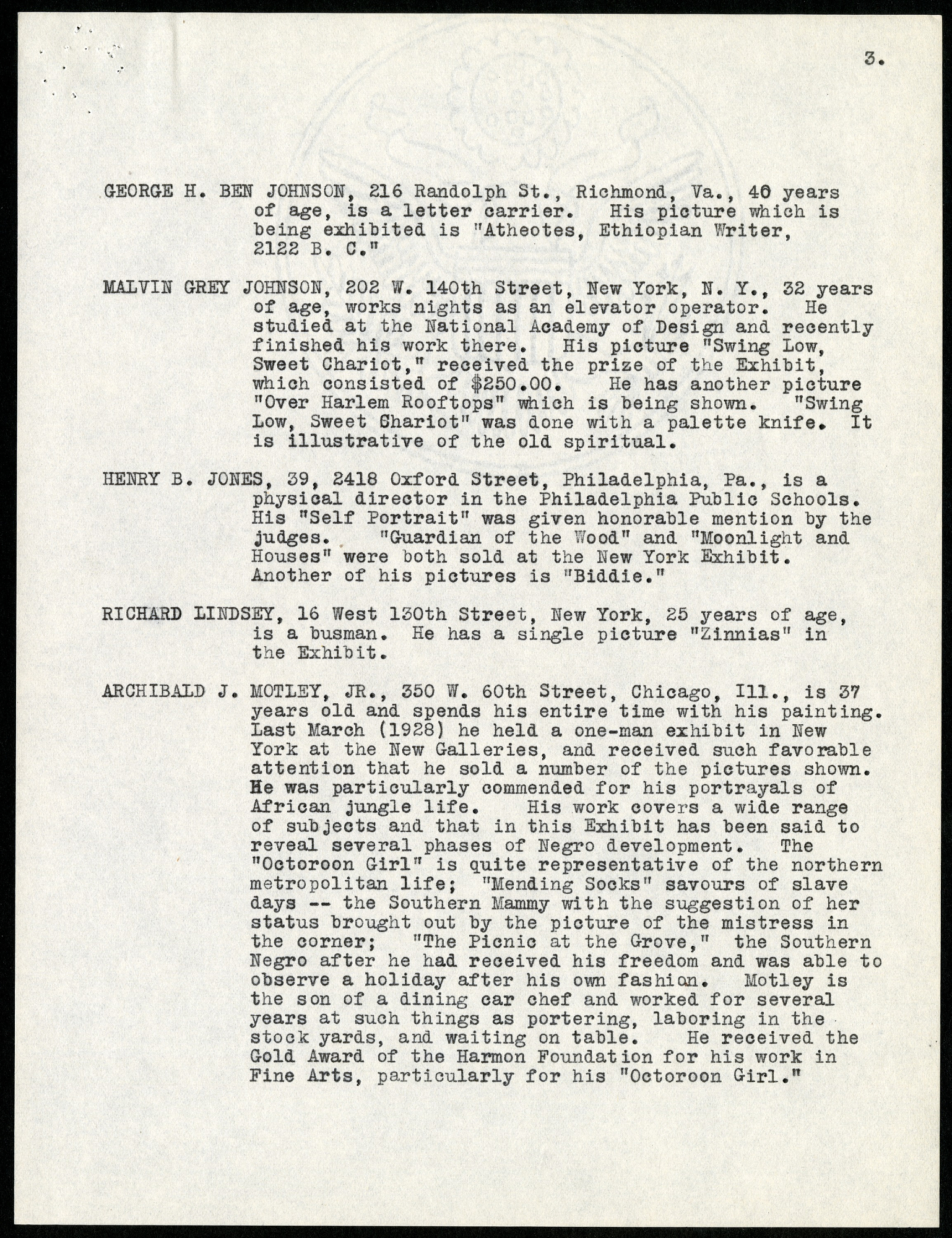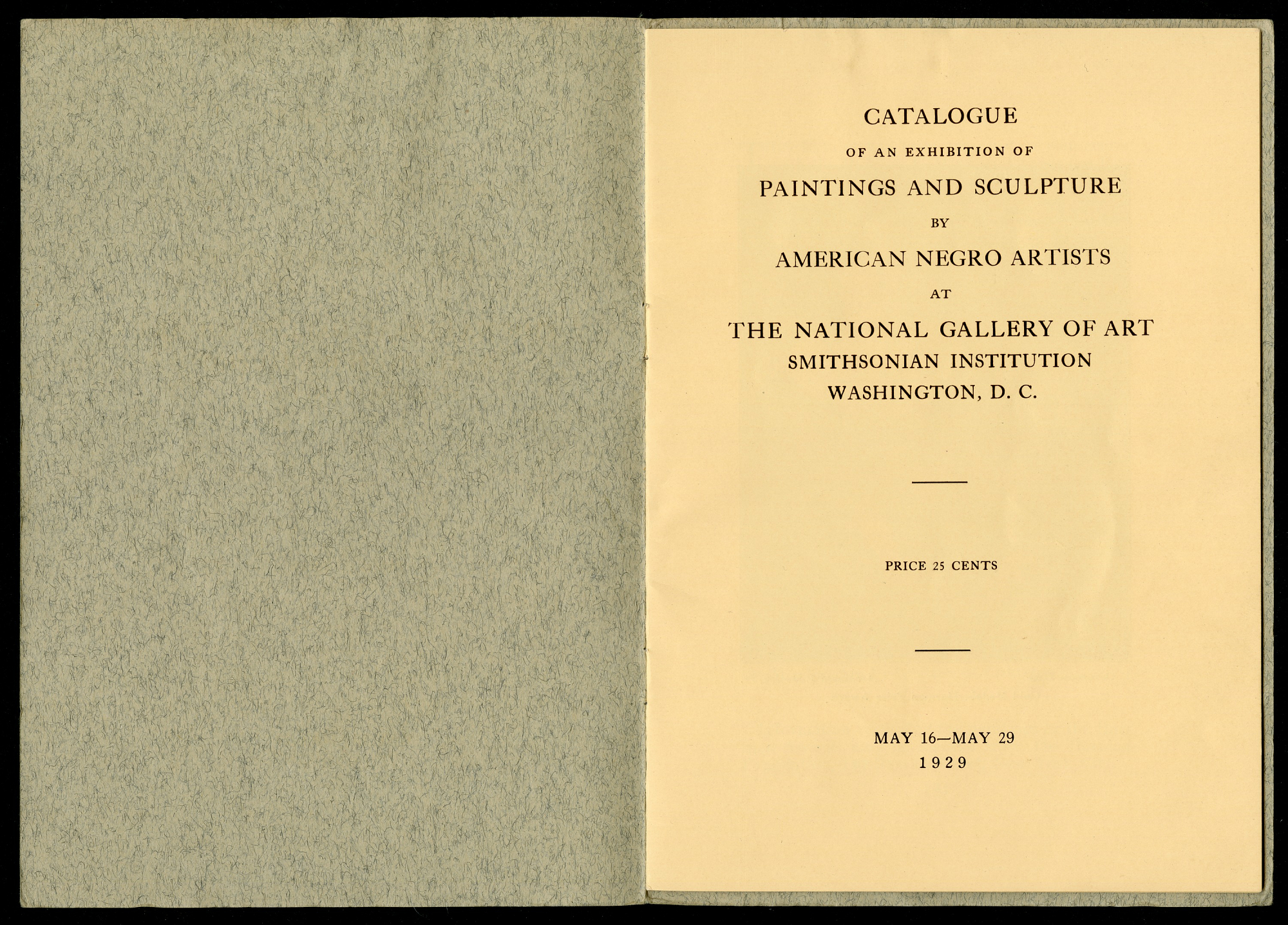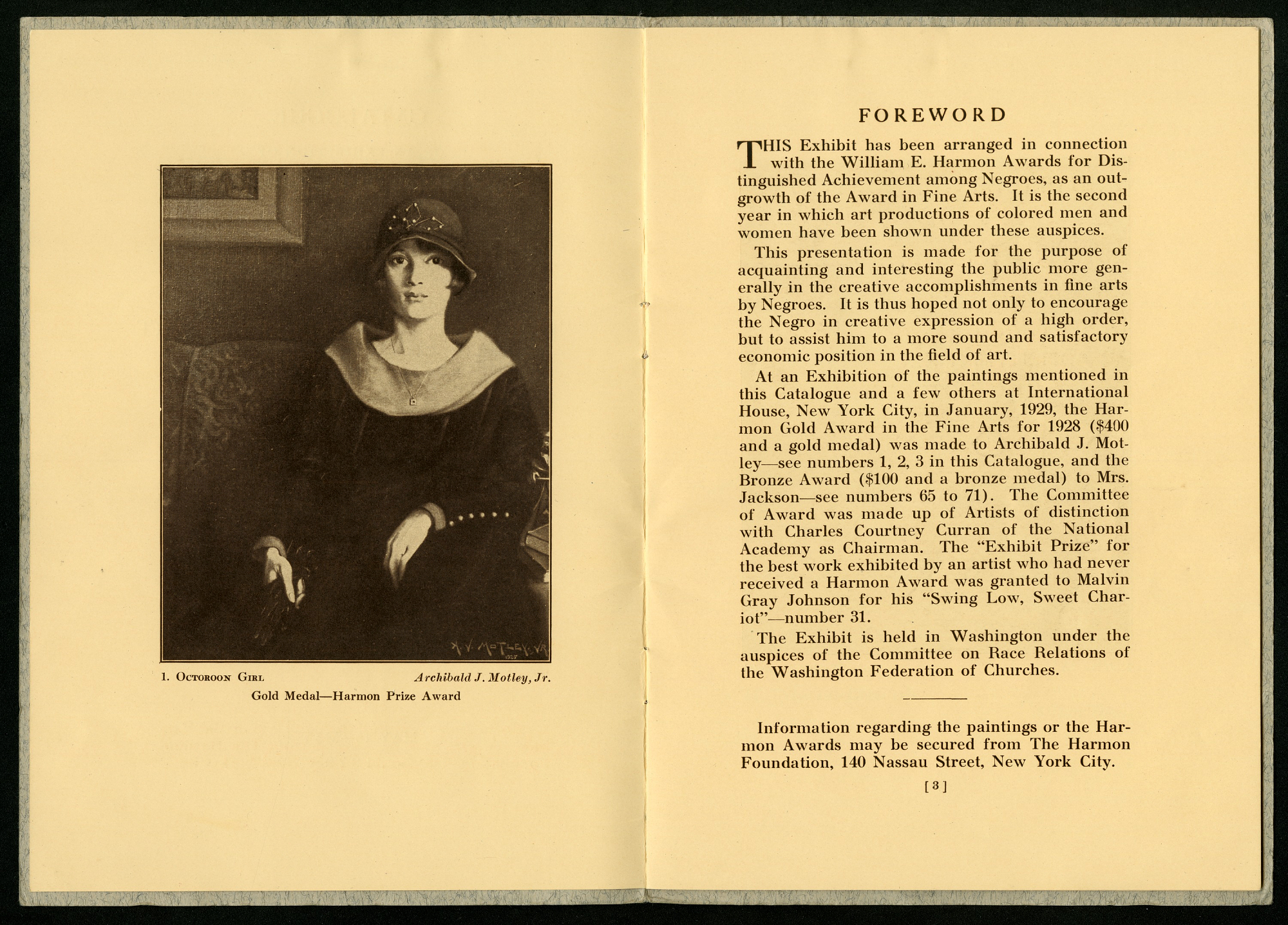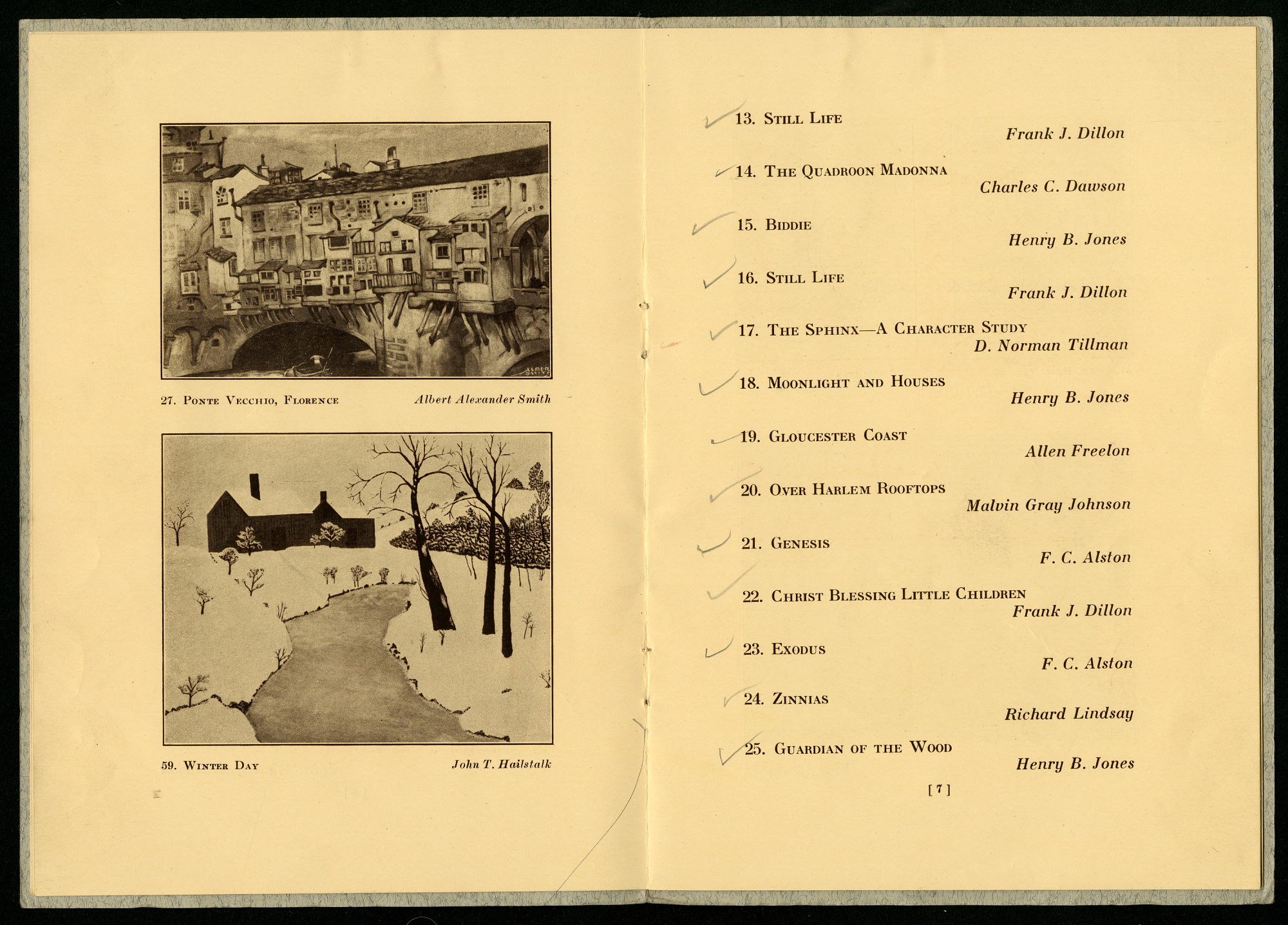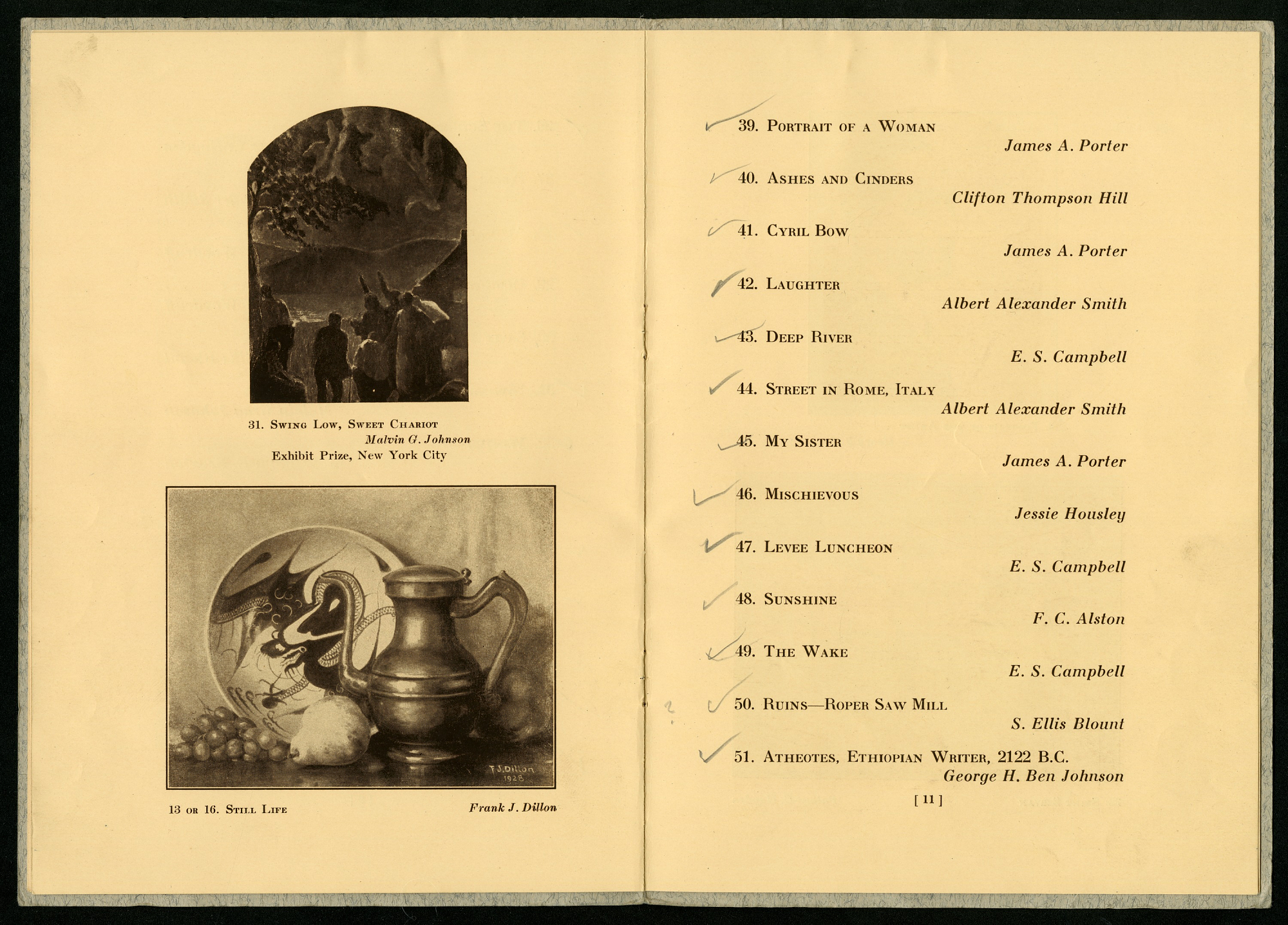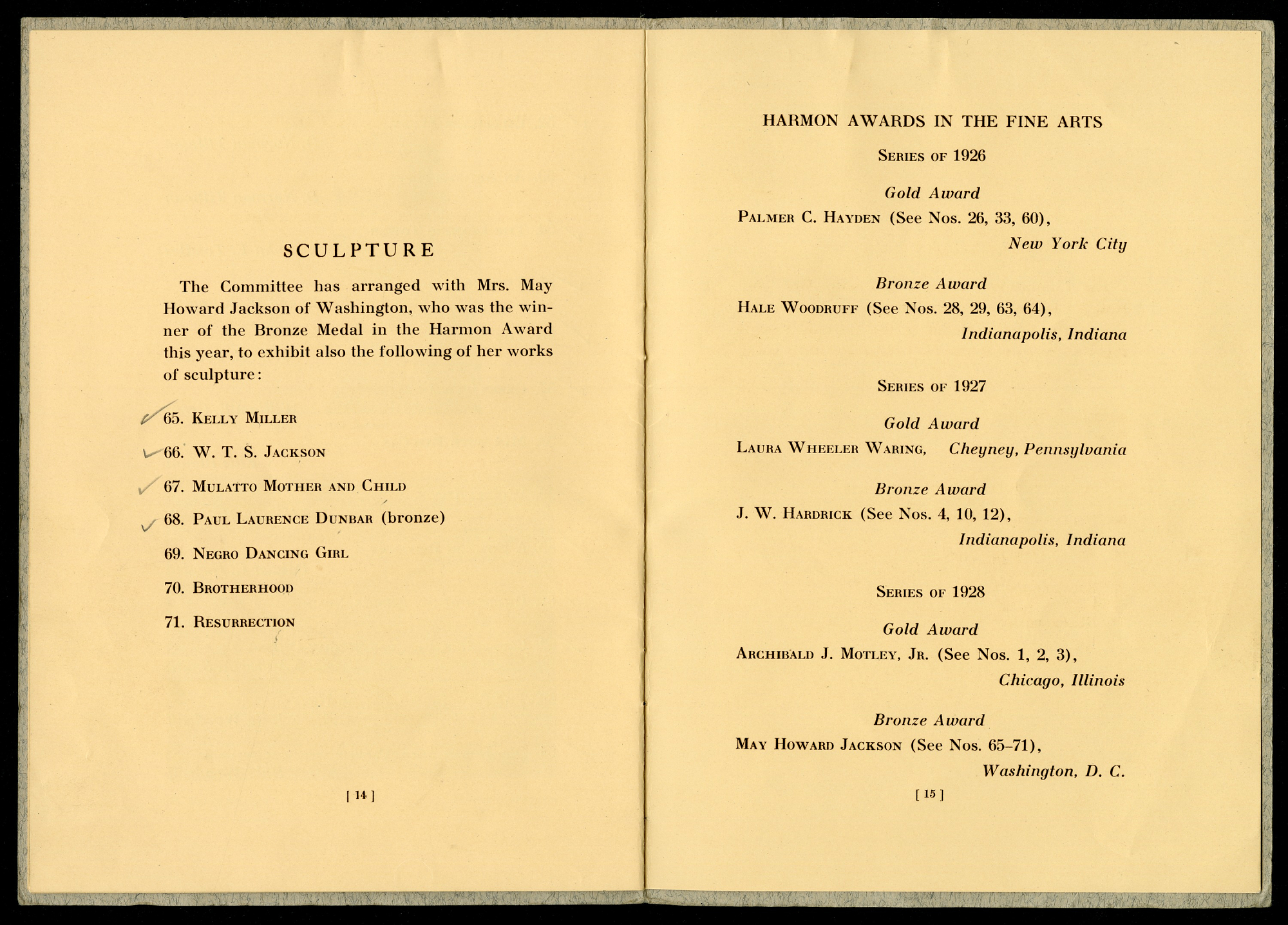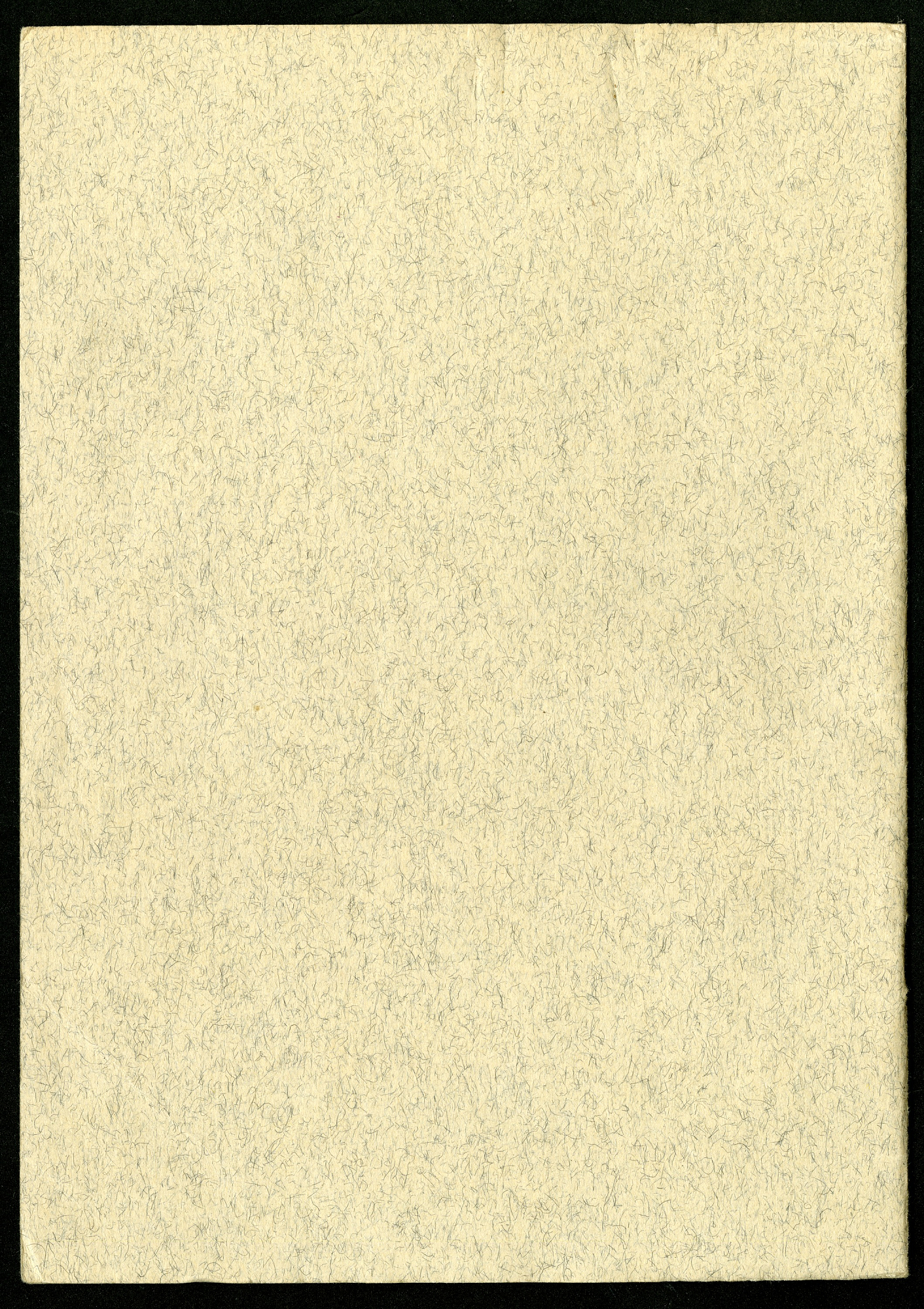American Negro Artists (National Gallery of Art, 1929-1930)
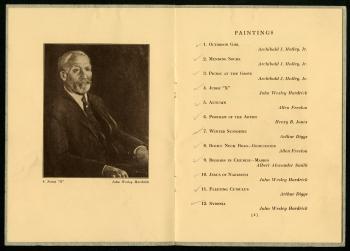 On May 16, 1929, an exhibition of American Negro Artists opened on the ground floor of the Smithsonian’s US National Museum building. The exhibition featured fifty-one works by twenty-seven black sculptors and painters who won a juried competition sponsored by the Harmon Foundation.1Though the work selected remained distant from the most radical new work being created by modernists in the 1920s, the exhibition was nonetheless revolutionary in its own way as the first collection of African American art to hang in the Smithsonian.
On May 16, 1929, an exhibition of American Negro Artists opened on the ground floor of the Smithsonian’s US National Museum building. The exhibition featured fifty-one works by twenty-seven black sculptors and painters who won a juried competition sponsored by the Harmon Foundation.1Though the work selected remained distant from the most radical new work being created by modernists in the 1920s, the exhibition was nonetheless revolutionary in its own way as the first collection of African American art to hang in the Smithsonian.
Prior to this exhibition the closest approximation to any representation of black life and culture was the Herbert Ward Collection of African artifacts. While Alain Locke and other black intellectuals of the Harlem Renaissance did value the African contribution to black art in America, the artifacts arranged in the Ward exhibit were meant to emphasize the distance between darkest Africa and white civilization.2 Many white visitors to the Africa hall were unwilling or unable to see a difference between the portrayal of these supposedly “savage” Africans and those of the African Americans whom they encountered on a day to day basis. Indeed, some of these same white visitors were certainly grateful that President Woodrow Wilson instituted segregation in federal buildings throughout the District of Columbia in 1913. They may also have been members of the mob that rampaged through DC’s black neighborhoods for four nights in the summer of 1919 seeking to drive black residents from the city that had arrived seeking wartime employment during World War One.3 They may even have been among the cheering crowds welcoming the 25,000 Klansman who paraded down Pennsylvania Avenue in 1925 as a demonstration of their political might.4
To display the work of these African American artists in this context served as an important, though subtle, rebuke to racist representations of black life in an era in which white supremacy was more or less unchecked.
Challenging Segregation
The American Negro Artists show was part of a traveling exhibition of African American art sponsored by the Harmon Foundation and the Federal Council of Churches (FCC). The idea for this traveling exhibition arose from the FCC’s Commission on Interracial Cooperation, organized in response to the nationwide spasm of anti-black riots that had swept the nation ten years previously, popularly known as the Red Summer of 1919.5It was the hope of this committee to build a foundation of interracial understanding and tolerance in order to forestall future violence by replacing “hostility and prejudice” with “brotherly goodwill.”6
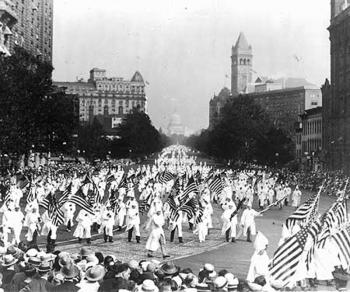 It fell to local Commission members Rev. Anson Phelps Stokes Jr., the Canon of the Washington Cathedral, and Dr. Emmett J. Scott of Howard University to secure a space to host the exhibition for its twelve-day stop in Washington, DC. After sounding out the Library of Congress and other options in the District, Rev. Stokes decided to contact the Smithsonian at the recommendation of Secretary Leila Mechlin of the American Federation of Arts.7 The Smithsonian was a smart choice. Though President Wilson had pressured the institution to impose Jim Crow, its partial autonomy from the federal government allowed it to resist these pressures. This gave Stokes and Scott some room for maneuver. In her letter to Stokes advising him on approaching Director William H. Holmes of the Smithsonian’s National Gallery of Art, now the Smithsonian American Art Museum, Mechlin suggested that he request access to a space in the museum other than “in that section given over to the National Gallery.”8 Rev. Stokes agreed to follow Mechlin’s advice; however, by doing so, he also ensured that American Negro Artists would remain at a distance from the gallery’s permanent exhibitions. Even though the Smithsonian did not bar African American visitors, Mechlin’s suggestion effectively segregated the exhibit within the Smithsonian.
It fell to local Commission members Rev. Anson Phelps Stokes Jr., the Canon of the Washington Cathedral, and Dr. Emmett J. Scott of Howard University to secure a space to host the exhibition for its twelve-day stop in Washington, DC. After sounding out the Library of Congress and other options in the District, Rev. Stokes decided to contact the Smithsonian at the recommendation of Secretary Leila Mechlin of the American Federation of Arts.7 The Smithsonian was a smart choice. Though President Wilson had pressured the institution to impose Jim Crow, its partial autonomy from the federal government allowed it to resist these pressures. This gave Stokes and Scott some room for maneuver. In her letter to Stokes advising him on approaching Director William H. Holmes of the Smithsonian’s National Gallery of Art, now the Smithsonian American Art Museum, Mechlin suggested that he request access to a space in the museum other than “in that section given over to the National Gallery.”8 Rev. Stokes agreed to follow Mechlin’s advice; however, by doing so, he also ensured that American Negro Artists would remain at a distance from the gallery’s permanent exhibitions. Even though the Smithsonian did not bar African American visitors, Mechlin’s suggestion effectively segregated the exhibit within the Smithsonian.
In the negotiations that followed, Holmes initially offered Stokes the use of the National Museum’s well-lit north lobby, which was currently the location of an exhibit of art from World War One. Since the show would be brief, the exhibition could be mounted on “screens encircling the space which [would] accommodate the exhibit without removing the World War Portraits from the walls.”9 However, Assistant Secretary Alexander Wetmore proved unwilling to accommodate the exhibit on these terms, claiming that exhibitions like this tend to cause “too much congestion” at the entrance of the building. Wetmore instead suggested that the exhibit be mounted in the foyer adjacent to the auditorium on the ground floor, which at that time was serving as a place to store unused exhibit cases.10
Though Holmes had been initially eager to accommodate the American Negro Artists exhibition, it was clear that Assistant Secretary Wetmore was not. This is most evident when Holmes raised concerns about the poor quality of the lighting in the foyer and even offered, “for the credit of the Institution, to undertake the Negro Exhibit in the Gallery” proper.11 Wetmore refused to allow this too, asserting that “the attendance” of so many African American visitors “might embarrass the first floor.”12 Though unable to deny access to someone as influential as the Canon of the Washington Cathedral, Wetmore could – in his capacity as the chief administrator of the National Museum – do a great deal to limit the access of any African American visitors to the museum. Regardless of these limitations, and anxious to secure such a prestigious venue, Rev. Stokes agreed to these terms.13
American Negro Artists
The exhibit proved wildly popular with nearly 2,600 people visiting on its first weekend. By the time the exhibit closed on May 27, 1929, more than 8,000 people crowded into the foyer of National Museum building to see the work on display, the vast majority of whom were African American.14 Most of the artwork had been created by men and women established enough in their careers to make their living as artists, including Archibald Motley whose award-winning painting “Octoroon Girl” was prominently featured in the exhibition. Visitors would also see early work by Palmer Hayden, who would in 1947 produce a famous series of paintings detailing the legend of John Henry. Or, they could acquaint themselves with the work of Hale Woodruff whose evocative murals of the Amistad mutiny would later grace the walls of Alabama’s Talladega College. The exhibition also included less famous artists like William E. Braxton, who earned his living as a waiter in a Brooklyn restaurant, and John Hailstalk, an elevator operator in Manhattan.15
The reviews were generally positive.16 Leila Mechlin, the Washington Star art critic who had helped get the show into the Smithsonian, called the exhibit “a very creditable showing.”17 Ada Rainey, writing in the pages of The Washington Post, stated that “the paintings show a high degree of excellence,” singling out several of the paintings for significant praise and detailed commentary.18 The Washington Herald’s Stanley Olmstead, though critical of many aspects of the exhibit, nonetheless pointed out the technical expertise and sophistication of the work.19
 The popularity of the 1929 show prompted Stokes to return to the museum with the same request the following year. This time, Director Holmes had changed his mind about supporting another exhibition and tried to dissuade Stokes. An internal memo from Holmes to Secretary Charles Abbot fretted that the 1929 show had been too “political,” and “of little interest save [among] the colored people.” He concluded that the National Museum was not the appropriate forum for such a display. Holmes even went so far as trying to secure another artist to fill the space so that there would be no room available in 1930. Viewed charitably, Holmes – then nearing retirement – may have been unwilling to embroil the Smithsonian in political controversy at the end of a long and distinguished career.20 However, it is clear that the large turnout of DC’s African American community for the 1929 show had made Holmes reluctant to welcome the exhibit again.
The popularity of the 1929 show prompted Stokes to return to the museum with the same request the following year. This time, Director Holmes had changed his mind about supporting another exhibition and tried to dissuade Stokes. An internal memo from Holmes to Secretary Charles Abbot fretted that the 1929 show had been too “political,” and “of little interest save [among] the colored people.” He concluded that the National Museum was not the appropriate forum for such a display. Holmes even went so far as trying to secure another artist to fill the space so that there would be no room available in 1930. Viewed charitably, Holmes – then nearing retirement – may have been unwilling to embroil the Smithsonian in political controversy at the end of a long and distinguished career.20 However, it is clear that the large turnout of DC’s African American community for the 1929 show had made Holmes reluctant to welcome the exhibit again.
Despite these concerns, Stokes was able to convince the Smithsonian to put on a repeat exhibition. It is likely that he once again called on the influential Leila Mechlin, who praised the 1930 show as “eminently worthy” of the public’s attention.21 However, this exhibit was once again confined to the poorly-lit foyer and would also be the last of its kind to be seen at the Smithsonian until well after World War Two.22 Even so, these two shows represented a small victory in securing black artists’ access to the National Museum. However, as historian Michele Gates-Moreci has observed, the need to assuage Holmes’s concerns made that victory dependent upon the charity of the Smithsonian.23
This is also perhaps why Rev. Stokes felt compelled to describe the 1930 exhibit in the pages of the Evening Star as “a field of Negro achievement where no controversial social or political questions are involved.”24That is, including a short exhibit of work by black artists approved by a relatively conservative committee of art critics in the nation and segregated to the auditorium foyer of the Smithsonian’s National Museum building would not “embarrass” white supremacy in any way. It would challenge neither the poll tax nor the rigid segregation that had been vigilantly maintained since the 1890s.
The Price of Admission
And this was the intended outcome. Stokes and the Commission on Interracial Cooperation were less interested in justice for African Americans than they were in establishing some basis for interracial cooperation in order to preserve peace between the races. Given the sheer amount of violence that had targeted black lives throughout the preceding decades, achieving any basis for interracial harmony was no small feat. However, the price of that peace was to set aside any claims on genuine equality.
Additionally, what Stokes, Scott and the African American artists they represented faced was how to negotiate inclusion into an institution that tolerated but did not fully accept their presence. Though the Smithsonian’s National Museum stopped short of outright exclusion, they did segregate the exhibit into a space in the museum where black visitors could be controlled and marginalized. Given the constraints of life in a time when segregation not only went unchallenged, but was viewed as the most sensible way of mediating between the races, this was probably the best outcome possible. True equality of representation and access would have required Director Holmes and Assistant Secretary Wetmore to set aside their concerns about political controversy and open the regular gallery to African American artists and visitors.
Despite the price paid by these artists, these exhibits were the first representations of black life and culture in the Smithsonian that were at least partially controlled by African Americans themselves. It would remain a high water mark of black representation at the Smithsonian until the arrival a new generation of black museum directors and curators that arrived in the 1960s. These included people like John Kinard, the future director of the Anacostia Neighborhood Museum and Lonnie Bunch, the present director of the National Museum of African American History and Culture, who made it his life to encourage museums to “embrace controversy” as the only path for the voices of the excluded to be heard in the marble halls of the Smithsonian.25
FOOTNOTES
1 Smithsonian Institution Archives (hereafter SIA), Record Unit 311, National Collection of Fine Arts, Office of the Director, Box 35, Folder 3. Catalogue of an Exhibition of Paintings and Sculpture by American Negro Artists at the National Gallery of Art (1929). Return to text
2 Alain Locke, “The Legacy of the Ancestral Arts,” in The New Negro, ed. Alain Locke; for an extensive discussion of the Ward Collection see Michèle Gates-Moresi, “Exhibiting Race, Creating Nation: Representations of Black History and Culture at the Smithsonian Institution, 1895-1976” (Ph.D. diss, George Washington University, 2003), 69-76. Return to text
3 “Race Riot of 1919 Gave Glimpse of Future Struggles,” Washington Post, 1 March 1999, A1; Constance McLaughlin Green, The Secret City: A History of Race Relations in the Nation’s Capital (Princeton: Princeton University Press, 1967), 184-214. Note: contemporary estimates of the number killed in the immediate violence have ranged from 6-15. However the 1999 Washington Post estimate also included the fatality figures of those who died of their wounds after the fighting was over. This increased the death toll to 39. Return to text
4 “Ku Klux Klan Rally,” Histories of the National Mall, accessed May 4, 2016, http://mallhistory.org/items/show/175. Return to text
5 Gates-Moresi, 81-82. Return to text
7 SIA, Record Unit 311, National Collection of Fine Arts, Office of the Director, Records, Box 35, Folder 3. Stokes to Putnam, 12 Nov 1928; Putnam to Stokes, 14 Nov 1928; Mechlin to Stokes, 16 Nov 1928; Stokes to Holmes, 19 Nov 192. Return to text
8 SIA, Record Unit 311, National Collection of Fine Arts, Office of the Director, Records, Box 35, Folder 3. Mechlin to Stokes, 16 Nov 1928. Return to text
9 SIA, Record Unit 311, National Collection of Fine Arts, Office of the Director, Records, Box 35, Folder 3. Holmes to Abbot, 27 Dec 1928; Homes to Stokes, 27 Dec 1928. Return to text
10 SIA, Record Unit 311, National Collection of Fine Arts, Office of the Director, Records, Box 35, Folder 3. Wetmore to Abbot, 8 Jan 1929; Abbot to Holmes, 8 Jan 1929. Holmes to Stokes, 10 Jan 1929. Return to text
11 SIA, Record Unit 311, National Collection of Fine Arts, Office of the Director, Records, Box 35, Folder 3. Holmes to Wetmore, 24 April 1929. Return to text
12 SIA, Record Unit 311, National Collection of Fine Arts, Office of the Director, Records, Box 35, Folder 3. Holmes to Wetmore, 1 May 1929. Return to text
13 SIA, Record Unit 311, National Collection of Fine Arts, Office of the Director, Records, Box 35, Folder 3. Stokes to Holmes, 16 Jan 1929. Return to text
14 SIA, Record Unit 311, National Collection of Fine Arts, Office of the Director, Records, Box 35, Folder 3. Attendance during Negro Exhibit – North Door.” Return to text
15 SIA, Record Unit 311, National Collection of Fine Arts, Office of the Director, Records, Box 35, Folder 3. “Who’s Who of Artists on Exhibit.” Return to text
16 SIA, Record Unit 311, National Collection of Fine Arts, Office of the Director, Records, Box 35, Folder 3. Stokes to Holmes, 27 May 1929. Return to text
17 Leila Mechlin, “Notes of Art and Artists,” The Washington Star (Part 2), 19 May 1929, 4. Return to text
18 Ada Rainey, “Negro Art Exhibition has Merit,” The Washington Post, 19 May 1929, S9. Return to text
19 Stanley Olmstead, “An Exhibit of the Art of Negroes Opens Here,” Washington Herald, 17 May 1929, 11. Return to text
20 Gates-Moresi, 89. Return to text
21 Leila Mechlin, “Colored Artists in Exhibition Here,” Washington Star, 8 June 1930, B-2. Return to text
22 Gates-Moresi, 89-90. Return to text
23 Ibid, 91. Return to text
24 Rev. Anson Phelps Stokes Jr, Letter to the Editor: “Colored Art Exhibit at National Museum,” Evening Star, 6 June 1930, A-8. Return to text
25 Lonnie Bunch, “Embracing Controversy: Museum Exhibitions and the Politics of Change,” The Public Historian, Vol. 14, No. 3 (Summer, 1992), 64. Return to text


